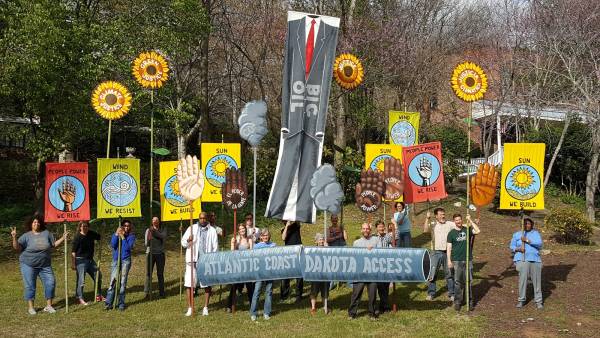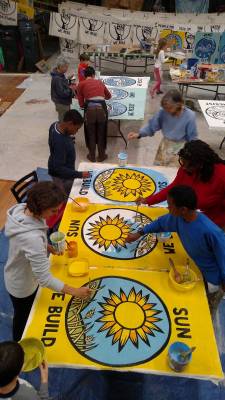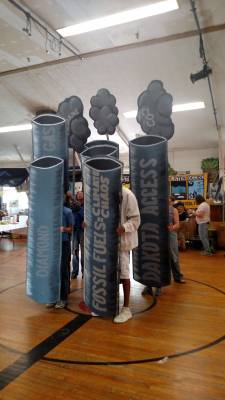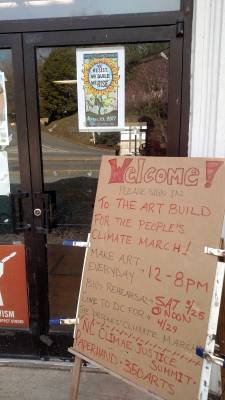Thousands of people from North Carolina will be marching in Washington DC on April 29 for the Peoples Climate Mobilization—and hundreds of them will also performing with giant puppets, art, theater and pageantry to tell the story of their battle against the Atlantic Coast Pipeline.
300 pieces of hand made puppets and art will process through downtown DC; joining the march, surrounding the White House and performing “Keeping it in the Ground,” a giant scale pageant theater at the National Mall. The epic art includes everything from giant flying cranes to a 50 foot-wide Mother Earth to 20 foot high big oil ‘empty suits’ to a sea of hands, sunflowers, Wind, Sun and People Power banners and 100-foot long pipeline that transforms into climate polluting smokestacks.
Here’s what they have planned and why you won’t want to miss it:

Photo Credit: David Solnit
Why they march: The Atlantic Coast Pipeline
Last month activists and community members who would face the direct impacts of the Atlantic Coast Pipeline walked 200 miles along the 550-mile route, which would transport fracked gas from West Virginia across the state and into Virginia and North Carolina. The walk, coordinated by the Alliance to Protect Our People and the Places We Live, brought together Indigenous folks, students, people of faith, black and white farmers, and climate justice activists.
“Our state of North Carolina, and particularly Eastern N.C., is in the throes of one of the most expensive and extensive proposed methane pipelines in the nation: the Atlantic Coast Pipeline. The public is becoming more aware of not only the harm of vast oil and gas production and use, but also their effect on climate change and global warming.” wrote Rev. Mac Legerton last month in the Fayetteville Observer. He continues, “The first two proposed routes took the pipeline near Durham and Raleigh, large cities with communities of significant wealth and political power. The third route now takes the pipeline through the poorest and most racially diverse region of the state and possibly the nation. There is a long history of placing what is dubbed “dirty” industry in low-income, rural communities.”
Ericka Faircloth of the The Coalition of Woodland Nations says, “This pipeline threatens sacred sites of the Monacan Tribe in Virginia and the Tuscarora and Waccamaw peoples of North Carolina. The terminus is in Robeson County, North Carolina, home of the Lumbee Tribe and one of the densest populations of American Indians on the East Coast. The Coalition of Woodland Nations is asking all American Indian tribes and organization in the U.S. to support our stand against the Atlantic Coast Pipeline.”

Photo Credit: David Solnit
Art and the Climate Justice Movement
Connie Leeper, a leader of the North Carolina Climate Justice Summit (NCCJS) explains why they are choosing to bring giant theater and art to DC: “Cultural work sustains our passion and joy while growing our movements. It helps our communities to keep moving forward by aligning our heads, hearts, and hands. Art and theater make us think and feel deeply while bypassing the tedium of talking heads.”
NCCJS is an ongoing network that meets each year to help weave together groups fighting the Atlantic Coast Pipeline together with others. At the Summit, “together we explore grassroots solutions that make our communities more resilient, more equitable and more powerful as we work to avert climate chaos.”
Using puppetry to win over hearts
For nearly 20 years Paperhand Puppet Intervention has charmed and amazed generations of North Carolinians with their annual giant puppetry Summer Show, telling socially relevant stories to thousands each year.
Last month Paperhand teamed up with the North Carolina Climate Justice Summit (NCCJS) and 350.org’s Art Organizing Project to tell the story of North Carolinians’—and everyone’s—fight to protect our climate and our communities. For two weeks families, puppeteers and community activists and organizers made hundreds of puppets and pieces of art that will go to DC to tell their story on a hard-to-ignore scale that will fill the streets of DC and the Capitol.
Paperhand co-founder Jan Burger says, “When we make art and theater together we are acting out and making real our dreams. Making art collaboratively, together, is a humble way to be, we show our vulnerability to each other, and so we strengthen our trust and love in one another. Those are the qualities that the world sees. We can win over people’s hearts that way.”
The fight to protect North Carolina, our water and all of us, comes to head in the coming months as the Atlantic Coast pipeline permit will be issued or denied by the Federal Energy Regulatory Commission, or FERC. NCCJS leader Jodi Lasseter says, “Art is the engine of social movements…it’s what moves us collectively, re-imagining what is possible and actualizing our power to co-create the world we want.”
For tips, tricks, and sample designs to make your own art for the Peoples Climate March, click here.

